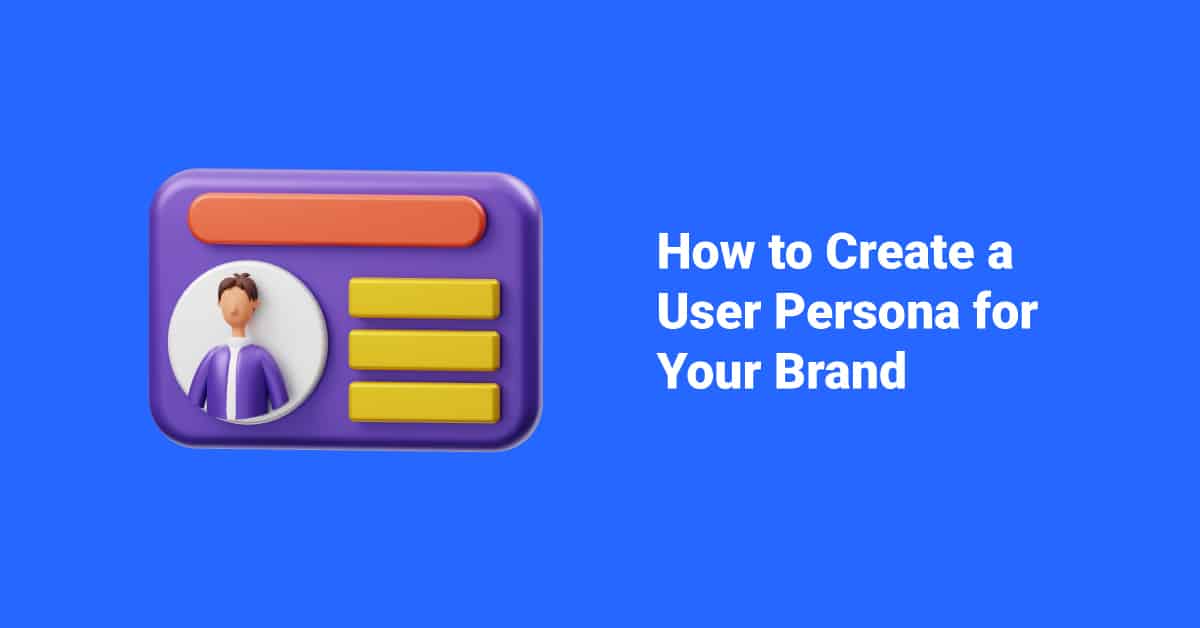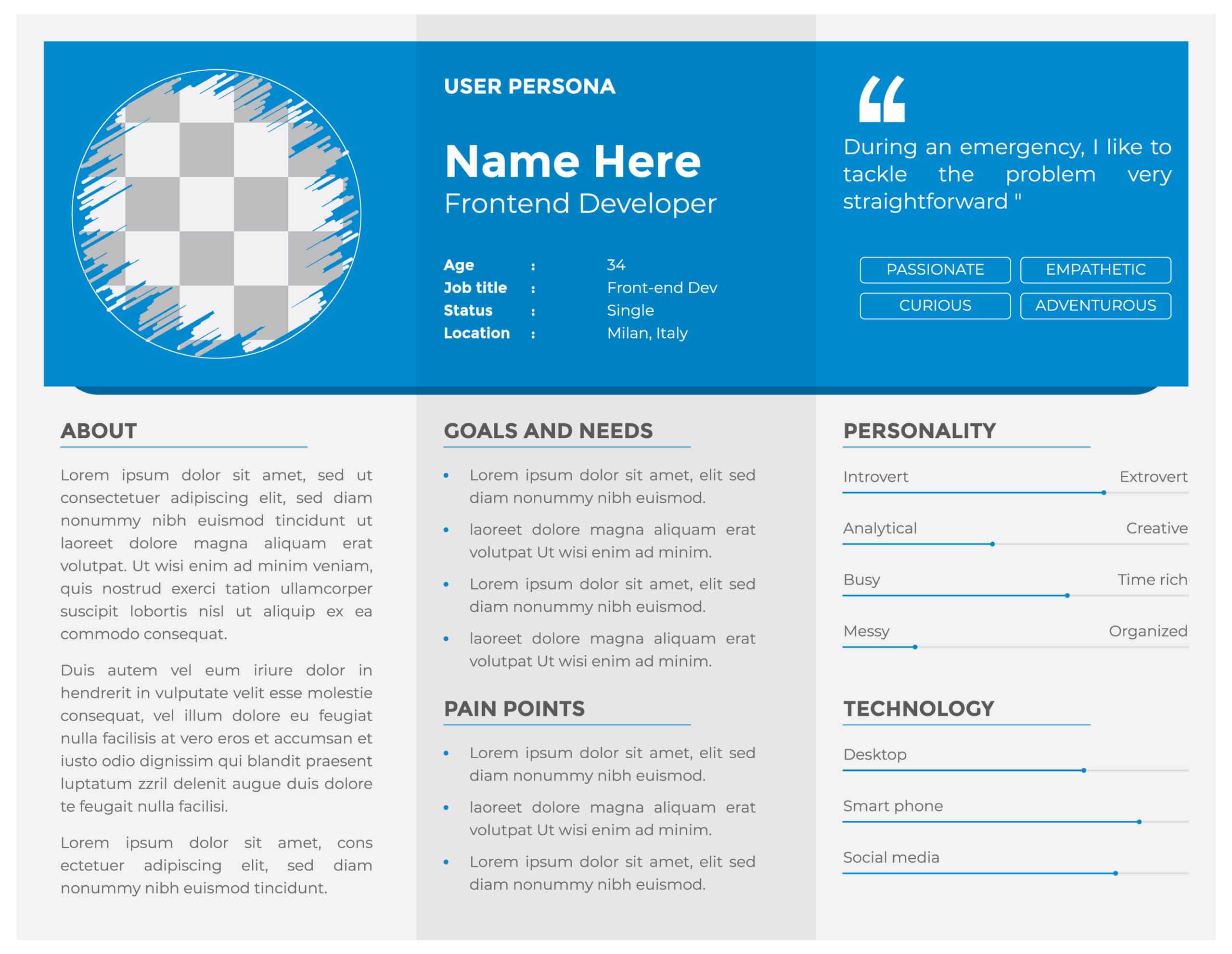User Personas are used by marketers to describe potential users of a product or service. They’re based on research into the needs and behaviours of people in similar situations.
What is a User Persona and
Why Do You Need One for Your Brand?
A persona is a fictional character who represents a group of real people. A persona is not an exact representation of any one individual; rather, it’s a composite of several individuals with common characteristics. A user persona is a representation of your ideal customer. It is an archetype that is based on real data and research.
By creating a user persona for your brand, you will be able to understand your target audience better, what their needs are, and how to appeal to them. It will help your team members or design team to make great design decisions for better user research, user experience (UX design), website design brief, and web design process.
In this blog post, we will teach you how to create a user persona for your business. We will also provide some examples and samples so that you can get started right away!

How To Understand Your Audience Needs and Wants?
A user persona helps you do just that. By creating a profile of your ideal customer, you can better understand what he or she wants and needs. This understanding allows you to design a product or service that meets those needs.
How to Create a User Persona Profile?
Creating a user persona might seem like a daunting task but it doesn’t have to be! You can start by identifying some basic demographics about your ideal customer. Once you have this information, you can start to fill in the rest of the details about your user persona. Here are some questions to get you started:
-What is their age?
-Where do they live?
-What is their job title?
-What are their interests?
-What are their pain points?
Once you have answered these questions, you will have a better understanding of who your user persona is. You can then use this information to create marketing campaigns that appeal directly to them. By doing this, you will be able to reach your target audience more effectively and efficiently. Additionally, you will save money by not wasting resources on marketing strategies that don’t work.
Develop Personas Based on Data.
You can develop personas based on data. For example, you might start by looking at the demographics of your current customers. Then, you can use that information to identify other people who share similar characteristics. Next, you can research these individuals to learn more about them. Finally, you can combine demographic and behavioural data to create a persona.
Are There Any Other Ways to Use a User Persona for Your Business Growth Goals?
Yes! There are many other ways to use a user persona for your business growth goals. For example, you can use a persona to:
- Identify new market opportunities
- Develop products and services that meet the needs of your target audience
- Create marketing campaigns that resonates with your target audience
- Improve customer retention rates
A user persona can be an extremely valuable tool for any business. By taking the time to create one, you will be able to better understand your target audience and what they want and need. Additionally, you will be able to save time and money by using a persona to guide your marketing efforts. So what are you waiting for? Get started today!
You can also use FREE tools like hubspot: create my persona
5 Tips For Creating Great User Personas
1 . Demographic is different than Persona
When you’re creating personas, it’s important to remember that a persona is not the same as a demographic. A demographic is a description of who your customer is. A persona is a description of who your ideal customer is.
For example, let’s say you sell women’s clothing. Your target demographic might be “women aged 18-35.” But your persona would be something like a “ fashion-forward woman who loves to experiment with new styles.” See the difference? The persona is much more specific and helps you understand what kind of clothing your ideal customer would want to buy from you.
2. Start small, and expand after
When you’re first starting out, it’s important to create personas for your core target market. Once you have a good understanding of who they are, you can expand to other markets. Trying to understand too many different customers at once will only make process more difficult and confusing.
To start, sit down and brainstorm a list of all the different types of people who could potentially be interested in your product or service. Then, narrow that list down to the top three or four groups that are most likely to buy from you. These are the groups you should focus on when creating your personas.
As your business grows, you can add additional personas to your marketing campaigns. This will help you reach a wider range of customers and grow your business even further.
3. Base Your Personas on Real People
Your personas should be based on real people, not just made up. To create a persona that’s based on a real person, start by interviewing your current customers. Find out as much as you can about them, such as their age, location, job title, interests, pain points, and so forth. This information will give you a good starting point for creating your persona.
If you don’t have any current customers, reach out to your target market and ask if they’d be willing to participate in an interview. You can also look for case studies of people who have used your product or service successfully. Use these examples to help you create a well-rounded persona that represents your ideal customer.
Once you have a few personas created, take some time to review them and make sure they’re realistic. If they seem too good to be true, chances are they are. Don’t be afraid to make adjustments to your personas as needed.
4. Talk To Your Users in the Audience if Possible
If you have the opportunity to talk to your users in person, take it! This is a great way to get to know them on a personal level and understand their needs and wants. Even if you can’t meet with them in person, try to find ways to connect with them online.
For example, you can join relevant forums and social media groups where they hang out. You can also create surveys and polls to gather feedback from them directly. The more you interact with your target market, the easier it will be to create accurate personas that represent them.
When talking to your users, pay attention to the language they use. This will help you when creating marketing campaigns that resonate with them. For example, if they use a lot of industry-specific jargon, you’ll want to make sure your campaigns are using that same language. This will help them feel like you understand their needs and are speaking their language.
Keep in mind that your user’s needs may change over time. That’s why it’s important to keep in touch with them and stay up-to-date on the latest trends. This way, you can adjust your personas and marketing campaigns accordingly.
5. Keep an open mind
Creating user personas is a helpful exercise for any business, but keeping an open mind is important. Your personas are meant to be a guide, not a rulebook. They should help you make better marketing decisions, but they shouldn’t limit your creativity.
Don’t be afraid to experiment with new ideas and campaigns that fall outside of your persona guidelines. You never know what might work until you try it. And even if something doesn’t work out the way you planned, you can always learn from your mistakes and use that information to adjust your personas accordingly.
The most important thing is to stay flexible and keep an open mind when it comes to marketing your business.
User personas are a valuable tool that can help you market your business more effectively. By taking the time to create accurate personas, you can better understand your target market and create campaigns that speak directly to their needs. Keep these tips in mind as you start creating your own user personas and you’ll be well on your way to success.
User Persona Examples:
Now that we’ve gone over how to create a user persona, let’s take a look at different examples.
Example #01: The Busy Professional
-Name: Sarah
-Age: 35
-Location: New York City, NY
-Job Title: Marketing Director
-Interests: Running, yoga, spending time with family and friends
Sarah is a busy professional who doesn’t have a lot of free time. She is always on the go and is always looking for ways to save time. She is interested in products and services that can help her save time and make her life easier.
Example #02: The Stay-at-Home Mom
-Name: Emily
-Age: 30
-Location: Los Angeles, CA
-Job Title: Stay-at-Home Mom
-Interests: Cooking, baking, spending time with her kids
Emily is a stay-at-home mom who loves to cook and bake. She is always looking for new recipes to try and enjoys spending time with her kids. She is interested in products that can make her life easier and help her save time.
Example #03: The Retired Senior Citizen
Name: John
Age: 65
Location: Miami, FL Job Title: Retired Senior Citizen Interests: Traveling, gardening, playing golf
John is a retired senior citizen who loves to travel and garden. He is always looking for new places to visit and enjoys spending time outdoors. He is interested in products that can help him stay active and healthy.
As you can see, there are many different types of user personas. By taking the time to create a persona for your target users, you will be able to understand your target users. Additionally, you will be able to save time and money by using a persona to guide your marketing efforts. So what are you waiting for? Get started today!

